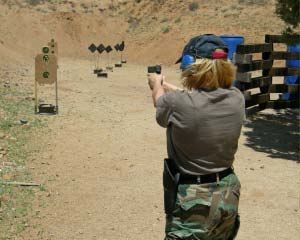Empathy
A Counterargument to "Virtue and Guns"
A response by David Yamane.
Posted May 24, 2019 Reviewed by Ekua Hagan

A while back, I wrote about some potentially harmful consequences related to particular forms of gun use and character. I'm happy to publish a very thoughtful response by David Yamane:
In an entry on his Ethics for Everyone blog post earlier this year, Michael Austin considers the neglected relationship between guns and virtue. He begins his essay by drawing on my argument that the center of gravity of American gun culture has shifted over the past 50 years from hunting and recreational/sport shooting (Gun Culture 1.0) to personal protection and concealed carry (Gun Culture 2.0).[2] So far, so good.
But Austin goes on to suggest, as summarized in his subtitle, “How ‘Gun Culture 2.0' can harm character.” He writes:
To the extent that the Gun Culture 2.0 instills in people a willingness to kill, it can be harmful to their character. My claim is not that owning and using a gun necessarily compromises character. But if one does so, and adopts much of what Gun Culture 2.0 involves, it can have a negative impact.
His argument that Gun Culture 2.0 can have a negative effect on people’s character is based on a particular perspective on human nature, a particular understanding of gun training, and a particular view of virtue and character. Based on my 7+ years of participation in and observation of Gun Culture 2.0, I disagree with Austin on each of these three parts of his argument.
On Violence and Human Nature
Austin begins by arguing that “a vast majority of us have a deep psychological resistance to killing other people.” There is a grain of truth here. I have seen individuals leave required concealed weapon carry courses because they could not come to terms with the possibility of having to shoot another person.
But the roots of this resistance to killing are important to specify. Austin maintains that our resistance is “natural,” a “feature of human nature.” But 70,000 years of violence in human history suggests the opposite. The survival of homo sapiens in Africa was predicated on our ability to enact lethal violence on game and cousin species. Killing is deep in our human DNA.[3]
Far from being a feature of human nature, our contemporary psychological resistance to killing is profoundly social. As Steven Pinker has documented exhaustively, violence has declined in human history not because our nature has changed, but because we have evolved social structures (e.g., the centralized state that monopolizes legitimate force) and cultures (e.g., recognizing universal human rights) that limit inter-personal violence. These social conditions then allow “the better angels of our nature” to come to the fore, particularly in more socially developed parts of the world where levels of homicidal violence are lower.[4]
Gun Culture 2.0, therefore, does not depend on people overcoming a natural aversion to killing. Rather, it helps individuals overcome our very recent culturally-taught and socially-learned resistance to interpersonal violence. It does so by helping individuals see that it is indeed appropriate at times to use our human capacity for violence pro-socially, in defense of self, loved ones, children, the weak and infirm, and other innocents. Gun Culture 2.0, to borrow an idea from sociologist Harel Shapira, sees defensive violence as “civilized” rather than barbaric.
On Gun Training
Austin next argues that one way to overcome resistance to killing is through gun training in which people are conditioned “to fire a gun at another human being without really thinking about the action that is being performed.” What is true of military training is true of Gun Culture 2.0, according to Austin, “insofar as a big part of that culture involves firing at human-shaped targets.”
Although it is impossible to study what happens in a random sample of gun training courses, and therefore difficult to generalize, my experiences as a participant-observer in gun training courses across the country over several years suggests Austin’s view is overly simplified.
It is true that human or humanoid targets are frequently employed in civilian defensive gun training courses. Some of these targets are quite graphic in depicting the brain, heart, spinal column, etc. But the mere presence of these targets does not mean that the instruction is tantamount to Pavolvian operant conditioning to kill.
In the first place, it is important to understand the nature and purpose of shooting drills. Drills, according to gun trainer Mike Pannone of CTT-Solutions, are designed to exercise component skills like drawing a gun quickly, shooting accurately, reloading efficiently, and managing malfunctions skillfully.
In his essay, Austin gives two examples of a drill called “rolling thunder.” This drill requires shooters to coordinate their actions with the person next to them, adding some stress and complexity to the underlying component skill being exercised. Although not a common drill, I once observed “rolling thunder” at Gunsite Academy in Arizona, the birthplace of the civilian gun training industry. Like the second rolling thunder drill Austin mentions, this drill was done at night for a specific purpose, as one small part of an hours-long unit teaching students how to use a flashlight to identify a threat in the dark.
Rolling thunder drills, like other defensive firearms drills, allow shooters to practice intentionally certain shooting skills. They don’t, as Austin contends, create “a quick-shot reflex which can weaken the natural resistance to killing another human being.” On the contrary, as host John Johnston and his guests on Ballistic Radio regularly highlight, the more mastery an individual has of the component skills of shooting, the less “cognitive load” that person bears when it comes to managing actual defensive situations. That is, not having to worry as much about the physical details of gunhandling and marksmanship frees the mind to make good, ethical decisions about the use of force in self-defense. Drills, therefore, ultimately make defensive firearms users less reflexive rather than more reflexive in response to threats.
Drills also need to be understood in the broader context of the classes in which they are taught. In the first course I took back in 2012, one of the pioneers of civilian gun training, Massad Ayoob, insisted from the start that life is precious and the use of lethal force is a cosmic decision that is not to be made lightly. In the most recent course I took earlier this year, one of the leading next-generation trainers, Craig Douglas, began by asserting, “A good self-defense course should begin with not letting it get shitty.” We spent the first two hours of his course learning about and practicing conflict de-escalation and “the high art of de-selection” as a victim.
The defensive orientation taught in firearms courses places a strong emphasis on the possibility of using lethal force in self-defense, not its desirability. Although there are always going to be a few bad apples, most defensive gun owners are not “itchin’ for a fight” and most defensive firearms trainers do not teach students to “shoot first and ask questions later.”
On the contrary, to borrow from gun journalist Michael Bane (from whom I also took the concept of Gun Culture 2.0), awareness and avoidance are usually the best defense. As Mike Pannone teaches in his courses, always avoid and evade first. But if that fails, be capable and willing to defend, not because you want to, but because you have to in order to align your behaviors with your moral purpose of defending innocent human life.
On Virtue and Character
In the end, Austin argues, by weakening our resistance to killing, Gun Culture 2.0 weakens our empathy. Because “empathy is important for good character,” Gun Culture 2.0 ultimately harms our character.
Even ignoring problems with the first two links in his chain of argumentation, this third part of Austin’s argument fails on its own terms. Austin allows that a “morally virtuous person who, as a last resort, kills an assailant in self-defense (or in defense of another person) may not be guilty of a morally unjust act.” (Ignore the odd qualifier “may” here.) But Austin immediately adds, “Nevertheless, if that person has good character, is empathetic, compassionate, and loving, she ‘will feel regret at having been the agent of killing.’”
As I was writing this final part of my response, a 22-year-old man entered a classroom at UNC-Charlotte and shot 6 people, 2 fatally. As is well known now, one of those fatally shot was 21-year-old student Riley C. Howell. Although the details are not entirely clear at this point, it appears that Howell charged the gunman, took him off his feet, and possibly held him down until police officers arrived.
He is being hailed as a hero for having engaged in an altruistic act reflecting the virtues of courage and compassion. But what if he had engaged the killer with a gun? Would he have been less heroic? Less virtuous? Did the killer deserve Howell’s empathy at that moment? His compassion? His sympathy? His kindness?
What if Howell had killed the attacker and thereby saved two lives, including his own? Would he, as Austin suggests a person of good character should do, “feel regret at having been the agent of killing”? If he did not feel regret but instead felt a measure of pride at having saved the lives of innocent others, would that be evidence of a lack of good character?
Austin asserts that a morally virtuous person will regret killing another person. No doubt, some will. But it is not hard to imagine other equally morally virtuous people (I know some personally) who would regret not doing everything within their power—up to and including killing another person—to save their own lives or the lives of other innocents, especially those falling under the mantle of their protection.
Gun Culture 2.0 does not in any sense advocate violence for violence’s sake. Rather, reflecting the empathy that Austin rightly praises, it takes the view that in a civilized society such as our own, “Violence is rarely the answer, but when it is, it’s the only answer.”[5] When employed lawfully and judiciously, violence, including lethal violence, is virtuous—not harming a person’s character but rather expressing it.
David Yamane is a Professor of Sociology at Wake Forest University. He blogs about guns in America at gunculture2point0.com and guncurious.com.
References
[1] Acknowledgements: I appreciate Michael Austin’s willingness to post this reply. This essay benefitted from input from John Correia, John Johnston, Randy Miyan, Mike Pannone, and Patrick Toner.
[2] Yamane, David. 2017. “The Sociology of U.S. Gun Culture.” Sociology Compass 11(7):e12497. https://doi.org/10.1111/soc4.12497.
[3] Bloom, Richard W. and Nancy Dess. 2003. Evolutionary Psychology and Violence: A Primer for Policymakers and Public Policy Advocates. Westport, Conn: Praeger. Arguably, violence comes more naturally to us human beings than reading these words does. See Fischer, Claude. 2019. “Brain Twisting, or How We Evolved.” MADE IN AMERICA. Retrieved May 6, 2019 (https://madeinamericathebook.wordpress.com/2019/05/06/brain-twisting-or…).
[4] Pinker, Steven. 2011. The Better Angels of Our Nature: Why Violence Has Declined. New York: Viking. Ironically, the very state monopolization of the legitimate use of force has also been the source of the largest scale acts of human violence in recent history.
[5] Larkin, Tim. 2017. When Violence Is the Answer: Learning How to Do What It Takes When Your Life Is at Stake. New York, NY: Little, Brown and Company, p. 3.
Photo CCL: https://creativecommons.org/licenses/by/2.0/




